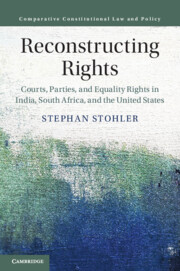 Reconstructing Rights
Reconstructing Rights Book contents
- Frontmatter
- Dedication
- Contents
- List of Figures
- List of Tables
- Acknowledgements
- Abbreviations
- Part I Introduction
- Part II United States of America
- 2 Equality Rights in American Education and Public Spending
- 3 Equality Rights in American Employment
- 4 Equality Rights in American Representation
- Part III India
- Part IV South Africa
- Part V conclusion
- Bibliography
- Index
- Series
2 - Equality Rights in American Education and Public Spending
from Part II - United States of America
Published online by Cambridge University Press: 09 July 2019
- Frontmatter
- Dedication
- Contents
- List of Figures
- List of Tables
- Acknowledgements
- Abbreviations
- Part I Introduction
- Part II United States of America
- 2 Equality Rights in American Education and Public Spending
- 3 Equality Rights in American Employment
- 4 Equality Rights in American Representation
- Part III India
- Part IV South Africa
- Part V conclusion
- Bibliography
- Index
- Series
Summary
Shortly after the adoption of Title VI of the Civil Rights Act of 1964 governing public spending, universities adopted affirmative action admissions policies. These policies potentially conflicted with the guarantees of Title VI and the Fourteenth Amendment. The Democratic and Republican parties adopted evolving views of these legal texts, potentially bringing them into conflict with the judges they had previously appointed. Instead, I demonstrate that aligned judges on the US Supreme Court worked in a deliberative fashion with their aligned elected counterparts to develop novel interpretations of Title VI and the Fourteenth Amendment. In some instances, however, novel judicial efforts went beyond the wishes of partisans in the elected branches, causing judges to retreat in ways that would be expected by the deliberative partnership thesis.
Keywords
- Type
- Chapter
- Information
- Reconstructing RightsCourts, Parties, and Equality Rights in India, South Africa, and the United States, pp. 31 - 65Publisher: Cambridge University PressPrint publication year: 2019
